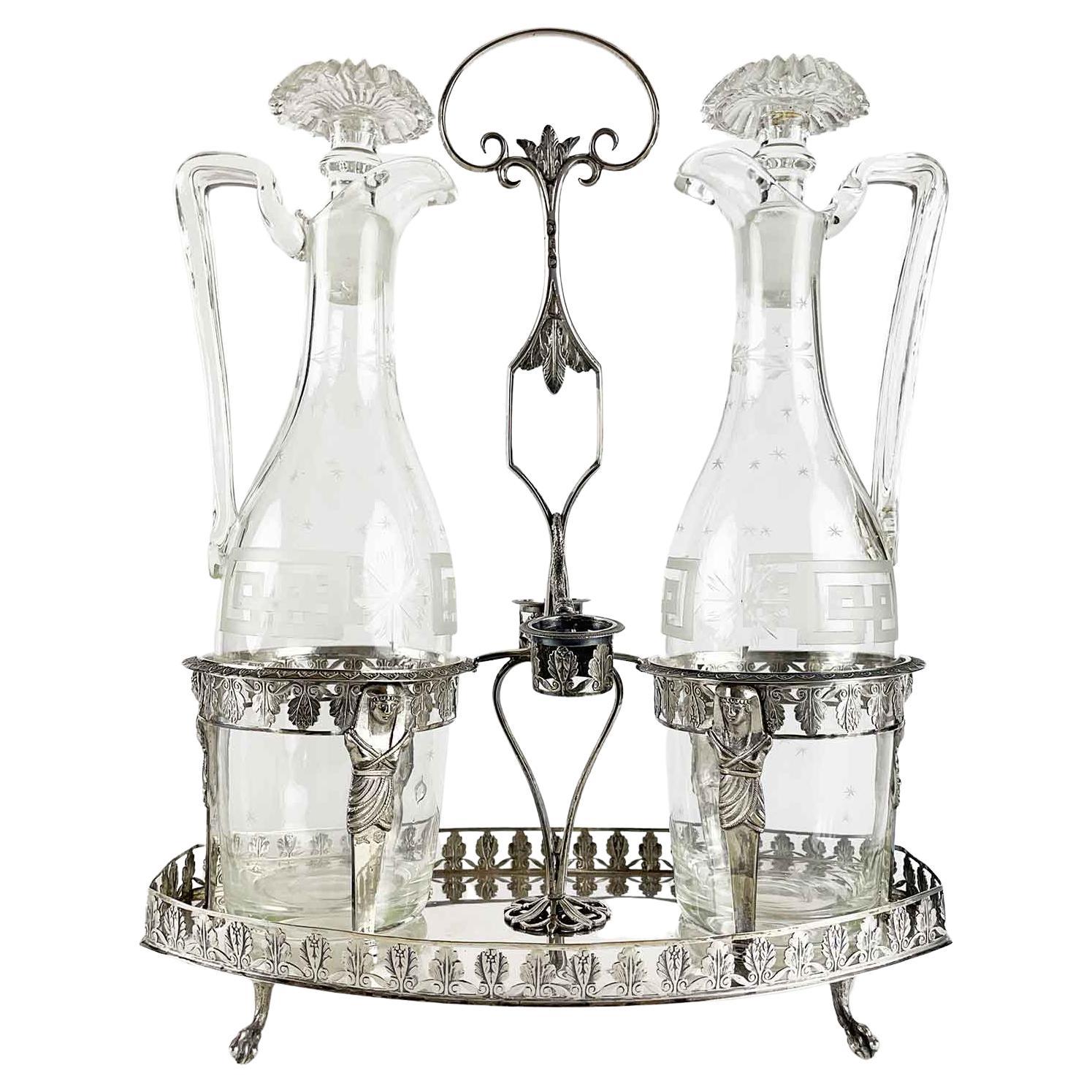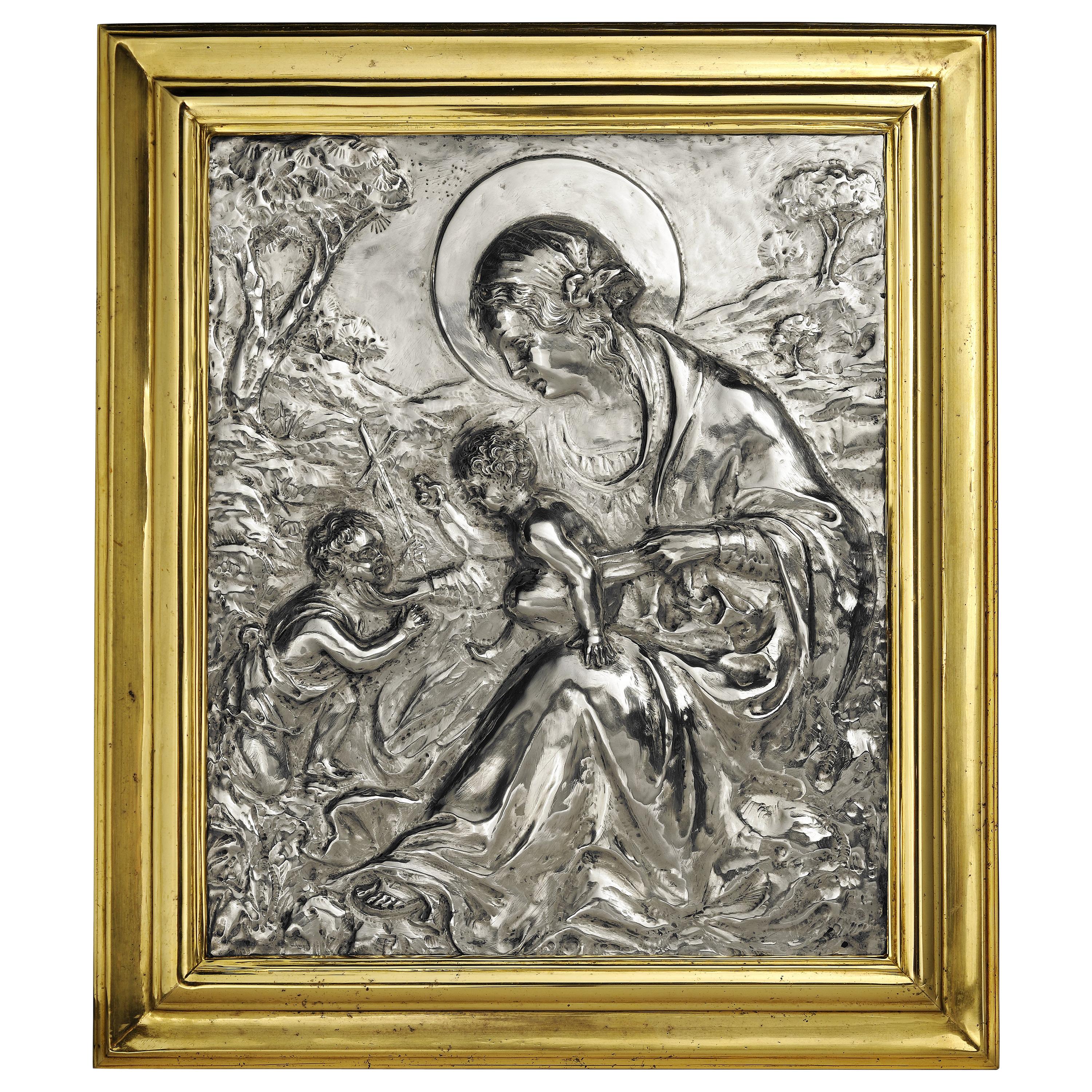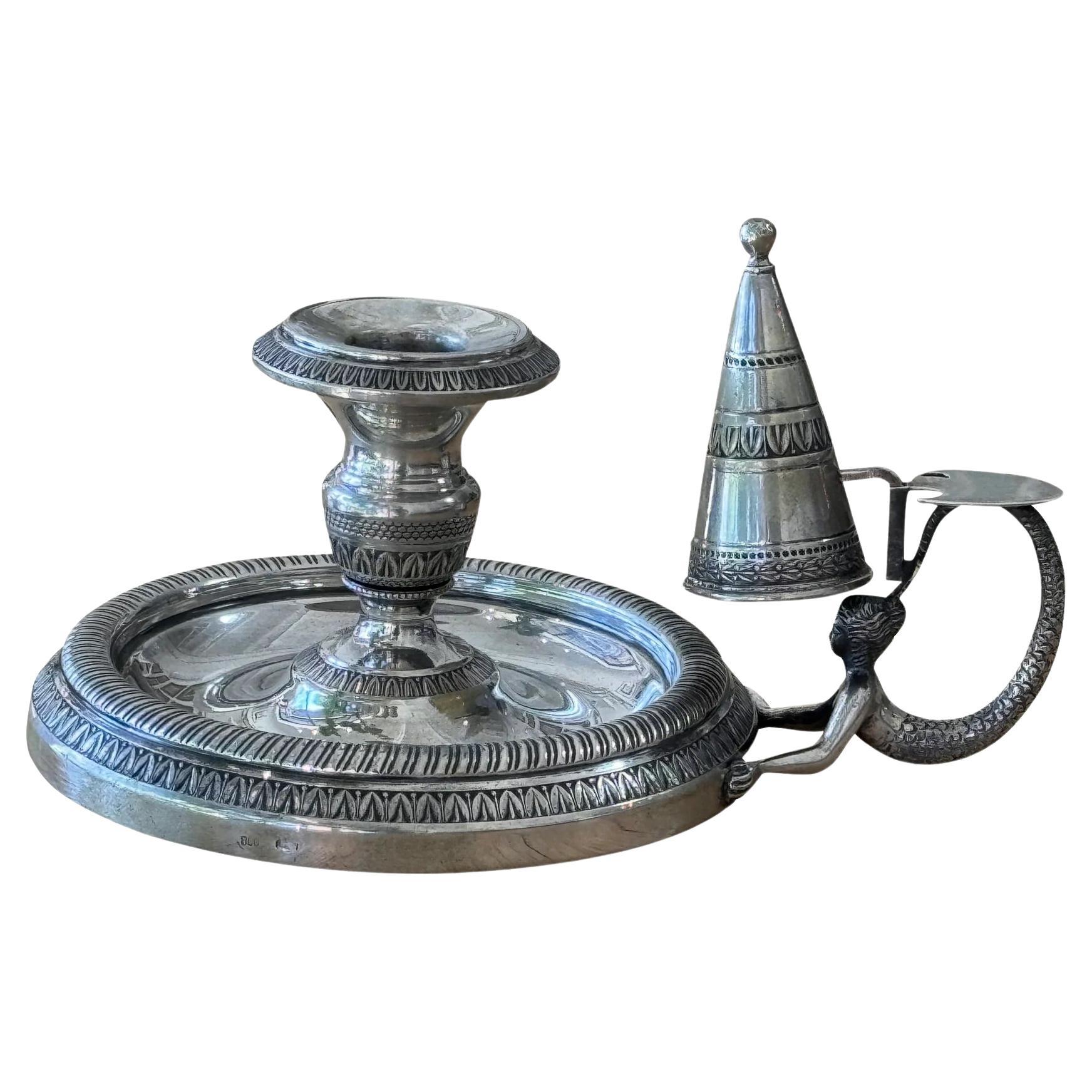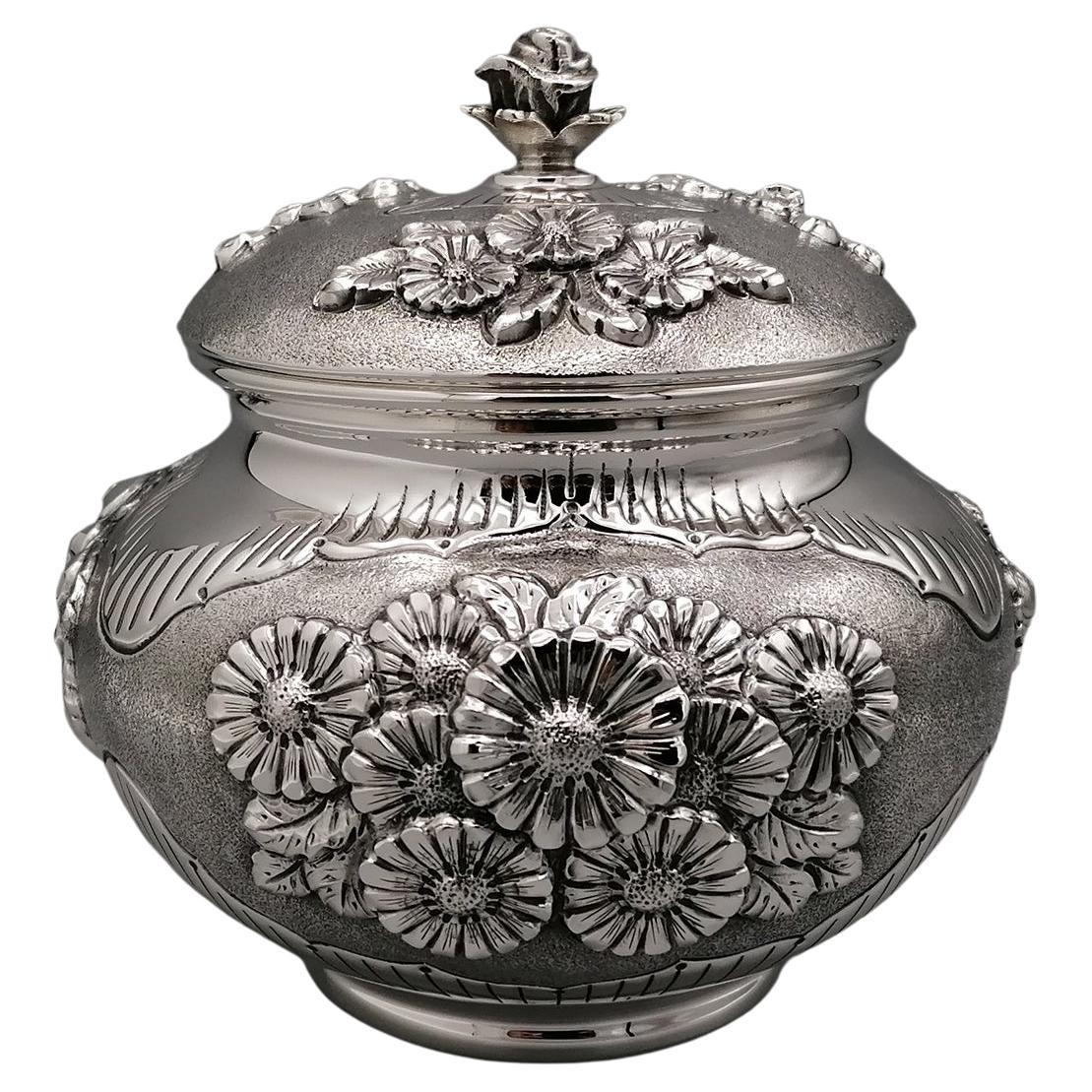Items Similar to 19th Century Italian Silver Oil Lamp Depicting Mercury After Giambologna
Want more images or videos?
Request additional images or videos from the seller
1 of 17
19th Century Italian Silver Oil Lamp Depicting Mercury After Giambologna
About the Item
Rare and exceptional 19th century silver oil lamp supported by the figure of Mercury after the model by Giambologna, by the Italian silversmith, Angelo Giannotti (1824-1865) of Bologna, circa 1850s. With the Papal State mark and mark of the maker which reads A99G. 33 by 14 by 8 in (86 by 24 by 20 cm).
- Dimensions:Height: 33 in (83.82 cm)Width: 8 in (20.32 cm)Depth: 14 in (35.56 cm)
- Style:Neoclassical (Of the Period)
- Materials and Techniques:
- Place of Origin:
- Period:
- Date of Manufacture:1880s
- Condition:Wear consistent with age and use. Minor losses. No apparent signs of restoration. The marble base has a few chips around the upper and lower parts.
- Seller Location:New York, NY
- Reference Number:1stDibs: LU881936835592
About the Seller
4.8
Vetted Seller
These experienced sellers undergo a comprehensive evaluation by our team of in-house experts.
Established in 1890
1stDibs seller since 2009
192 sales on 1stDibs
Typical response time: 5 hours
- ShippingRetrieving quote...Ships From: New York, NY
- Return PolicyA return for this item may be initiated within 3 days of delivery.
More From This SellerView All
- 19th Century Mercury After Giambologna Grand Tour Bronze SculptureLocated in New York, NYFinely cast Grand Tour patinated bronze figure of Mercury after the original by Giovanni da Bologna, aka Giambologna, in French, Jean de Bologne (1529-1608), Apparently unsigned.Category
Antique Late 19th Century Italian Neoclassical Revival Figurative Sculpt...
MaterialsMarble, Bronze
- Larger than Lifesize Grand tour Bronze Mercury Statue After GiambolognaBy GiambolognaLocated in New York, NYMonumental Italian Grand Tour bronze sculpture of Mercury, finely cast after the original model by Jean de Bologne (1529-1608), also known as Giambologna, mounted on square variegate...Category
Antique 19th Century Italian Neoclassical Figurative Sculptures
MaterialsBronze
- 19th Century Cloisonne Plate Depicting CranesLocated in New York, NYLovely antique (19th century) plate, 9 1/2 inches across, depicting cranes standing beside a running stream.Category
Antique 19th Century Metalwork
MaterialsMetal
- 19th Century Cloisonne Enamel Plate Depicting PeacockLocated in New York, NYLovely plate with fine cloisonne enamel designs depicting a peacock on light rocky ground and turquoise colored sky.Category
Antique Late 19th Century Metalwork
MaterialsMetal
- Pair of French 19th Century Bronze Corbeilles Depicting CupidsLocated in New York, NYPair of French 19th century patinated bronze corbeilles depicting cupids on marble bases.Category
Antique 19th Century French Decorative Baskets
MaterialsMarble, Bronze
- Pair 19th Century French Bronze Marly Horse Sculptures After CoustouBy Guillaume CoustouLocated in New York, NYPair of 19th century French bronze marly horse statues after the original models by Guillaume Coustou (1677-1746).Category
Antique Late 19th Century French Neoclassical Figurative Sculptures
MaterialsMarble, Bronze
You May Also Like
- 19th Century Italian Milanese Neoclassical Silver Oil and Vinegar Cruet SetLocated in Milan, ITAntique Milanese silver oil cruet consisting of an oval tray supported by four cast zoomorphic paw shaped feet; the edge of the tray is a ribbon decorated by...Category
Antique Mid-19th Century Italian Neoclassical Sterling Silver
MaterialsSilver
- 19th Century Italian Sterling Silver Madonna, circa 1830Located in Milano, ITEmbossed and engraved silver plaque La Madonna del lago (The Madonna of the Lake) Probably Milan, post 1824 Brass frame It measures 16.14 in x 13.85 in (41 x 35.2 cm) and it weighs 10.357 pounds (4.698 g): silver 1.31 pounds (598 g) + brass 9.03 pounds (4.100 g) State of conservation: some abrasions on the bottom. The frame is old, but not original. The plaque is made up of a sheet of embossed and engraved silver, and held in a solid brass frame. It depicts the “Madonna del lago” – “Madonna of the Lake” - (the Madonna with Child and San Giovannino) by Marco d'Oggiono (Oggiono, 1474 circa - Milan, 1524 circa), while changing only the background landscape. Almost certainly the subject reproduced in the plaque was taken from a famous engraving by Giuseppe Longhi (Monza, 1766 - Milan, 1831), one of the greatest engravers of his era. The silver is unmarked, probably because originally the Madonna was due to be exposed in a church: sometimes precious metals destined for worship and liturgical use would be exempted from payment and were, therefore, not marked. It is very likely that the plaque was made in Milan because in this city in 1824 the engraving by Giuseppe Longhi was made and printed. In addition, in Milan, the alleged lost painting by Leonardo da Vinci in his Milanese period (1482-1500) would be produced; this is the painting from which Marco d'Oggiono took his version. The painting Marco d?Oggiono was one of Leonardo da Vinci's most brilliant students and collaborators (D. Sedini, Marco d’Oggiono, tradizione e rinnovamento in Lombardia tra Quattrocento e Cinquecento, Roma 1989, pp. 151-153, n. 56; p. 225, n. 124, with previous bibliography). His style reflects in every way that of the Tuscan Maestro, so much so that he was the one who executed some copies of da Vinci's paintings. The execution of the “Madonna del Lago” probably draws inspiration from a lost painting by the Maestro, created while he was living in Milan (1482-1500). There are many similarities with other works by Leonardo such as the “Vergine delle rocce” or the “Vergine con il Bambino e San Giovannino, Sant’Anna e l’Agnello”. The painting, from which the drawing and then the famous engraving were taken, is found today at the M&G Museum of Bob Jones University in Greenville, South Carolina, where it came to rest after the sale of the Harrington Collection in London in 1917. The work appears in the inventories of the collection of Napoleon and Joséphine Bonaparte at the castle of Malmaison, before 1809. The Malmaison building was born and developed in the 17th and 18th centuries. In the 18th century it belonged to Jacques-Jean Le Coulteux du Molay, a wealthy banker. Later, during the Directory, Joséphine Bonaparte de Beauharnais bought it on April 21st, 1799, but settled at the castle definitively only after her husband separated from her in 1809. She remained there until 1814, the year of her death. When Joséphine died, the estate passed to her son Eugène de Beauharnais, who moved to Munich with his whole family in 1815, bringing with him the collection of paintings he inherited from his mother. Eugène died in 1824 and his wife Augusta of Bavaria (von Bayern), unable to keep it, in 1828 sold the Malmaison to the Swedish banker Jonas-Philip Hagerman. It is likely that in this period Augusta also sold part of the paintings inherited from her husband, including the “Madonna del Lago”. This painting then came into the possession of Leicester Stanhope, fifth Earl of Harrington (1784 - 1862) and then was passed down to his descendants. In 1917, at the death of Charles, eighth Earl of Harrington, his brother Dudley inherited the title and properties and he put up a part of his collections for sale. Among these, precisely, the painting by Marco d'Oggiono was to be found. On the occasion of that auction the painting was presented as a work by Cesare da Sesto, by virtue of a handwritten note by the Countess of Harrington on the back of the table. However, already in 1857, the German critic Gustav Waagen had identified Marco d'Oggiono as the author of the painting, then exhibited in the dining room of Harrington House in London (Treasures of Art in Great Britain, in 4 volumes, London, 1854 and 1857). The engraving Giuseppe Longhi was one of the most renowned engravers in Italy between the end of the 18th century and the first quarter of the 19th century. In 1824 Giuseppe Longhi, based on a design by Paolo Caronni, made a famous engraving of the painting of Marco d?Oggiono. The activity of Longhi was then at the peak of his notoriety, enough to earn him very substantial commissions; it is not risky to suppose that some of his successful engravings were also reproduced using other means: in our case in silver. (A. Crespi, a cura di, Giuseppe Longhi 1766–1831 e Raffaello Morghen...Category
Antique 1820s Italian Neoclassical Sterling Silver
MaterialsSterling Silver, Brass
- Italian Silver Mermaid Chamberstick, 19th CenturyLocated in Charlottesville, VAItalian silver (with marks) chamberstick, 19th Century, having a wonderful mermaid thumb-hold. Find guilloche and rib, and floral -detailing on the stick and cap. 3” h. x 4 ¾” diam...Category
Antique 19th Century Italian Sterling Silver
MaterialsSilver
- 19th Century Italian Solid Silver BasketBy Arval Argenti ValenzaLocated in VALENZA, ITImposing flower basket in solid 800 silver with base. The body of the centerpiece is rounded and completely embossed by hand with a wicker basket design. In the upper part of the c...Category
21st Century and Contemporary Italian Other Decorative Baskets
MaterialsSilver
- 19th Century Italian Sterling Silver Decorative BoxBy Arval Argenti ValenzaLocated in VALENZA, ITCompletely handmade sterling silver candy box. The box is round and pot-bellied. Embossments and chisels of flowers were made all over the body. The box is divided into three sect...Category
2010s Decorative Boxes
MaterialsSterling Silver
- 19th Century Italian Neoclassical Silver and Crystal Compote with CoverBy Cristoforo CorbellaLocated in Milan, ITFrom Milan a 19th century Italian silver and crystal compote bowl in good condition from a private collection. This antique Neoclassical covered compote bowl has a very fine hand-chased vegetal decoration and engraving, a lovely cast engraved silver 800/000 finial and shows silver-maker’s mark for Cristoforo Corbella active in the first half of 19th century in Milan, contrada degli Orefici 3194. This antique silver compote of supreme craftsmanship stands on a three-lobed pedestal base with B L monogram engraved in the central part, features tripod legs decorated with neoclassical motifs, scrolls, flowers, rosettes supporting a circular upper ring adorned with elegant acanthus leafed piercing. Engraved crystal cup and a cover finely engraved with geometrical and vegetal pattern, surmounted by a cast gem finial. The following marks can be seen on the bottom of the foot and the upper edge of the compote, (the original descriptions are reported, as they appear on the documents of the State Archive of Milan): 1) “Forma eptagona. Globo col Zodiaco ed i setti (sic) Trioni” Heptagon form. Globe with the Zodiac and the seven Trioni (seven stars of the Ursa Major) Mark of the Guarantee Office in use in the Napoleonic Kingdom of Italy from 1812 for works with a title of 800 thousandths. 2) "Aratro" Plow Mark of the Guarantee Office in use in the Napoleonic Kingdom of Italy from 1812. 3) "insegna della Luna Piena...Category
Antique Mid-19th Century Italian Neoclassical Sterling Silver
MaterialsCrystal, Silver
Recently Viewed
View AllMore Ways To Browse
Sterling Oil Lamp
19th Century Silver Italy
Olive Carving
English Sterling Dessert Spoon
Cactus 1930
Glasses Silver Base
Antique Pedestal Fan
Goblet Cups
Antique Art Glass Boxes
Sterling Regatta Cup
Moses Brent
Breakfast Chest
Stuart Devlin Falcon 1979
The Stieff Co. On Sale
Tiffany Bottle Opener
Tiffany Caviar Spoon
Tiffany Rocket
Tiffany Spoon Enamel





